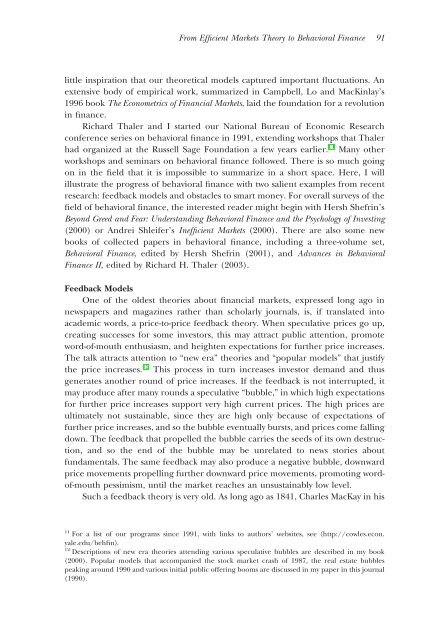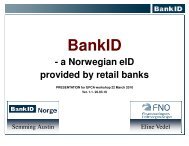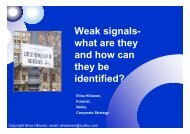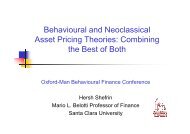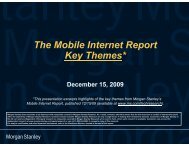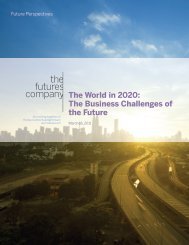From Efficient Markets Theory to Behavioral Finance
From Efficient Markets Theory to Behavioral Finance
From Efficient Markets Theory to Behavioral Finance
You also want an ePaper? Increase the reach of your titles
YUMPU automatically turns print PDFs into web optimized ePapers that Google loves.
<strong>From</strong> <strong>Efficient</strong> <strong>Markets</strong> <strong>Theory</strong> <strong>to</strong> <strong>Behavioral</strong> <strong>Finance</strong> 91<br />
little inspiration that our theoretical models captured important fluctuations. An<br />
extensive body of empirical work, summarized in Campbell, Lo and MacKinlay’s<br />
1996 book The Econometrics of Financial <strong>Markets</strong>, laid the foundation for a revolution<br />
in finance.<br />
Richard Thaler and I started our National Bureau of Economic Research<br />
conference series on behavioral finance in 1991, extending workshops that Thaler<br />
had organized at the Russell Sage Foundation a few years earlier. 11 Many other<br />
workshops and seminars on behavioral finance followed. There is so much going<br />
on in the field that it is impossible <strong>to</strong> summarize in a short space. Here, I will<br />
illustrate the progress of behavioral finance with two salient examples from recent<br />
research: feedback models and obstacles <strong>to</strong> smart money. For overall surveys of the<br />
field of behavioral finance, the interested reader might begin with Hersh Shefrin’s<br />
Beyond Greed and Fear: Understanding <strong>Behavioral</strong> <strong>Finance</strong> and the Psychology of Investing<br />
(2000) or Andrei Shleifer’s Inefficient <strong>Markets</strong> (2000). There are also some new<br />
books of collected papers in behavioral finance, including a three-volume set,<br />
<strong>Behavioral</strong> <strong>Finance</strong>, edited by Hersh Shefrin (2001), and Advances in <strong>Behavioral</strong><br />
<strong>Finance</strong> II, edited by Richard H. Thaler (2003).<br />
Feedback Models<br />
One of the oldest theories about financial markets, expressed long ago in<br />
newspapers and magazines rather than scholarly journals, is, if translated in<strong>to</strong><br />
academic words, a price-<strong>to</strong>-price feedback theory. When speculative prices go up,<br />
creating successes for some inves<strong>to</strong>rs, this may attract public attention, promote<br />
word-of-mouth enthusiasm, and heighten expectations for further price increases.<br />
The talk attracts attention <strong>to</strong> “new era” theories and “popular models” that justify<br />
the price increases. 12 This process in turn increases inves<strong>to</strong>r demand and thus<br />
generates another round of price increases. If the feedback is not interrupted, it<br />
may produce after many rounds a speculative “bubble,” in which high expectations<br />
for further price increases support very high current prices. The high prices are<br />
ultimately not sustainable, since they are high only because of expectations of<br />
further price increases, and so the bubble eventually bursts, and prices come falling<br />
down. The feedback that propelled the bubble carries the seeds of its own destruction,<br />
and so the end of the bubble may be unrelated <strong>to</strong> news s<strong>to</strong>ries about<br />
fundamentals. The same feedback may also produce a negative bubble, downward<br />
price movements propelling further downward price movements, promoting wordof-mouth<br />
pessimism, until the market reaches an unsustainably low level.<br />
Such a feedback theory is very old. As long ago as 1841, Charles MacKay in his<br />
11 For a list of our programs since 1991, with links <strong>to</strong> authors’ websites, see http://cowles.econ.<br />
yale.edu/behfin.<br />
12 Descriptions of new era theories attending various speculative bubbles are described in my book<br />
(2000). Popular models that accompanied the s<strong>to</strong>ck market crash of 1987, the real estate bubbles<br />
peaking around 1990 and various initial public offering booms are discussed in my paper in this journal<br />
(1990).


